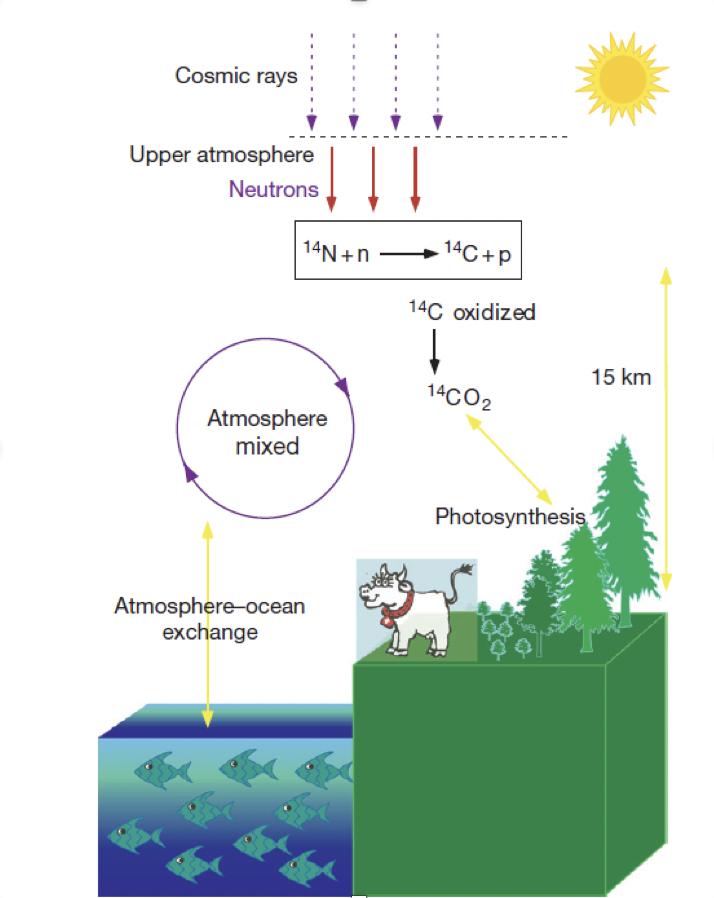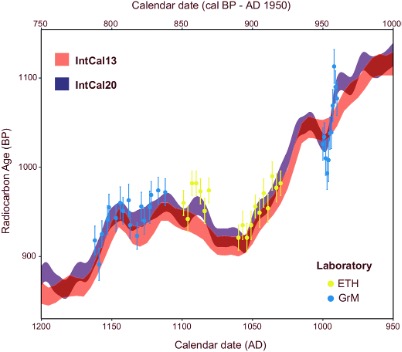New Radiocarbon Ages of Dead Sea Scrolls? Part 1
When we see historical events and accounts expressed as “XXX happened in XXX BC,” we take these dates at face value. However, have you ever wondered how historical dates were established? And how was that date obtained to that degree of accuracy? Was a date written somewhere on a piece of pottery or papyrus? Such questions have implications for Christianity where texts and scrolls were created thousands of years ago and where their credibility—and, hence, veracity—hinges greatly on their ages. In many such cases, radiocarbon dating is the key tool for establishing the chronology. Now, an advancement (this is part 1 of 2) in that tool promises to boost biblical credibility.
What Is Radiocarbon?
Carbon occurs in the form of two stable isotopes (12C and 13C) and one radioactive isotope (14C, radiocarbon), which is by far the rarest. When organisms die and no longer metabolize new carbon, the finite amount of radioactive carbon in their tissues begins to diminish without replacement at a rate determined by the law of radioactive decay. Every radioactive isotope has a characteristic half-life (the time during which half of all the radioactive atoms will decay). Plants and animals assimilate 14C from carbon dioxide throughout their lifetimes—thus, measuring the current rate of decay can be used to estimate the passage of time from a defined beginning point. (See “How Trustworthy Is Carbon Dating?” for details on radiocarbon production and half-life measurement.)

Figure 1: Production and distribution of radiocarbon in the environment.1
Radiocarbon has a half-life of 5700 +/- 30 years, which means that half the radioactive atoms disintegrate in that span, with each producing a nitrogen atom and a beta particle (14C => 14N + ß; figure 1).2 These estimates are normalized by reference to the year AD 1950, a convention established by international agreement to calibrate all laboratory results to a single reference year (“before present”), and to express the utilization of a standard measure of 14C concentration approximating the time before nuclear weapons changed the composition of the atmosphere (“before physics or BP”). Hence these numbers are aptly termed conventional radiocarbon age (CRA) and expressed as “XXX yr BP.” Note, however, that an extra calibration step is needed to convert CRAs to calendar years, and that’s where a calibration curve comes in.
Calibration Curves, IntCal20, and Implications for Dating of Biblical Texts
Global and local fluctuations of radiocarbon over long timescales have resulted in nonlinear trends in constructed “radiocarbon curves,” which incorporate information from proxies such as tree rings, lake and marine sediments, speleothems (limestone cave features), and even corals. The 1998 IntCal curve has undergone several notable revisions in 2004, 2009, 2013, and as recently as 2020,3 as more data and more robust statistical methods have been introduced. In the case of the latest version, named IntCal20, new datasets from new known-age tree rings, speleothem records (from caves that can be precisely U-Th dated), and varved (seasonally/annually laminated) sediment records from Lake Suigetsu (Japan) have been revised and extended. The construction of the IntCal20 calibration curve also utilized new statistical methods to make it more statistically robust.

Figure 2: Comparison of IntCal20 (blue) and IntCal13 (red) for the 250-year period from AD 950−1200 (1000–750 cal BP) showing the radiocarbon lab measurements (either ETH or GrM) from Lancaster Castle, error bars and envelopes at 1σ.4
Figure 2 shows small but more precise shifts in the radiocarbon curve from IntCal13 to IntCal20.5 Although such offsets are typically on the order of tens of years, such shifts have important implications for dating biblical texts. To test this, I recalibrated previously published dates of the Qumran Cave Dead Sea Scrolls6 using the latest version of calib.org (maintained by the authors of the IntCal20 paper).7 I then compared my recalibrations with palaeographic age estimates for these scrolls where some are date-bearing documents. Table 1 shows selected scrolls where the more precise and reliable IntCal20 validated the document dates or improved the chronological range of these scrolls.
Table 1: Recalibrated radiocarbon ages of Dead Sea Scrolls. Multiple calibrated ages represent probable age ranges due to imprecision of “wiggle-matching” (converting radiocarbon to calendar ages). The calibrated (IntCal20) ages in bold show better agreement with the paleographic age of these selected scroll fragments.

As radiocarbon curves continue to improve with better proxy records and robust statistical methods, they better constrain actual ages and even validate other techniques such as paleography in verifying the authenticity of Scripture. God has chosen to include many details in his Word, many of them verifiable and falsifiable. The mention of historical figures and events leaves the Bible open to attack, especially in terms of overall biblical chronology and time-sensitive historical events. However, since Christians hold that Scripture is inerrant, I firmly believe the new dating methods and techniques will unequivocally show that God’s Word (logos) is indeed “trustworthy, making wise the simple” (Psalm 19:7b).
Endnotes
- Figure 1 adapted from I. Hajdas, “14.3–Radiocarbon: Calibration to Absolute Time Scale,” Treatise on Geochemistry, 2nd ed., ed. Heinrich D. Holland and Karl K. Turekian (Elsevier, 2014), 37–43, doi:10.1016/B978-0-08-095975-7.01204-3.
- Many studies use 5730 +/-40 yrs, but the most recent measurements find a half-life of 5700 +/-30 as in Walter Kutschera, (2019). “The Half-Life of 14C—Why Is It So Long?,” Radiocarbon 61, no. 5 (October 2019): 1135–1142, doi:10.1017/RDC.2019.26.
- P. J. Reimer et al. (2020), “The IntCal20 Northern Hemisphere Radiocarbon Age Calibration Curve (0–55 cal kBP),” Radiocarbon 62, no. 4 (August 2020): 1–33, doi:10.1017/rdc.2020.41.
- Adapted from A. Bayliss et al., “IntCal20 Tree Rings: An Archaeological Swot Analysis,” Radiocarbon 62, no. 4 (August 2020): 1045–1078, doi:10.1017/RDC.2020.77.
- Bayliss et al., doi:10.1017/RDC.2020.77.
- See Bayliss et al., doi:10.1017/RDC.2020.77 and Georges Bonani et al., “Radiocarbon Dating of Fourteen Dead Sea Scrolls,” Radiocarbon 34, no. 3 (1992): 843–849, doi:10.1017/S0033822200064158.
- G. A. Rodley and B. E. Thiering, “Use of Radiocarbon Dating in Assessing Christian Connections to the Dead Sea Scrolls,” Radiocarbon 41, no. 2 (1999): 169–182, doi:10.1017/S0033822200019524.
- M. Stuiver, P. J. Reimer, and R. W. Reimer, 2021, CALIB 8.2 [WWW program] at http://calib.org.





